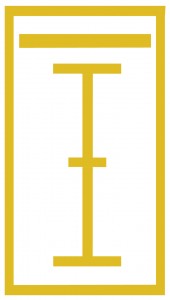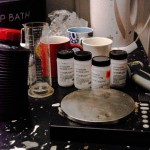Cinematographe: Hand Cranked Cinema
Cinematographe: Hand Cranked Cinema – An Abstract:
“Le cinéma est une invention sans avenir”
-Louis Lumière
At the time of the introduction of the Lumière brothers’ Cinématographe camera, film had yet to become an industrialized medium — there were no film labs for processing film, no theaters for professionally projecting one’s work, no skilled operators of cameras…and also, there were no rules. Instead it was the responsibility of the film maker to explore the vastly uncharted territory of the cinematic invention and to develop, by experimentation, methods for each aspect of a films production, including photography, processing, printing and projection. The Cinématographe was an embodiment of this mode of production being a device that not only recorded the image, but also acted as a contact printer and projector. Even the development of the negative and the print was accomplished by the camera operator, as per the original instructions for the device:
“The diverse operations of developing, fixing and washing films can be carried out conveniently with the help of simple buckets with a capacity of about ten litres. The film is unwound very quickly and plunged in such a way that it unwinds in the developer. When all the film is unwound you move it, always very quickly, into the second bucket, taking care to let it pass between your fingers to make sure that the entire surface is well coated with a layer of developing fluid and to avoid any bubbles or incomplete development which might arise. It is imperative that the immersion in the bucket, and the movement from the first to the second bucket, be carried out as quickly as possible.”
Not only that, but the Cinématographe was the first device of it’s kind which was easily deployable in the field rather than being tightly constrained to a studio. This was possible not only because of it’s relatively light weight (16 lb. / 7.3 kg), but also because of it’s use of a hand-cranked drive shaft as opposed to an electrically powered one such as with Edison’s Kinetograph.
As a result of each of these elements, the Cinématographe allowed for the film makers to explore both the science of light, motion and chemistry as well as the science of everyday life; more conductors of research than storytellers…
In this workshop, we will be exploring this form of film making whereby the camera, film strip, chemistry and projector are seemingly integrated with the body and mind of the film maker themselves. Participants will collaborate with one another to photograph, print and project 100 feet (approx. 2 minutes) of 35mm motion picture film using nothing more than gears, buckets and apertures.
This workshop will be occurring in association with TIE, The International Experimental Cinema Exposition
Attending the Workshop [Dates, Fees & Requirements]:
This workshop will be occurring on November 20th, 2013 between the hours of 12:30 PM and 9:00 PM. To reserve space for the workshop, contact us here.
The fees for attendance have not yet been determined and there are no other requirements for attending this workshop.
Agenda:
The following concepts will be discussed and explored in the course of this workshop
- Pre-industrial / post-industrial cinema
- Basic photography
- Operation of the 35mm hand cranked camera
- Filming of 100′ x 35mm black & white print stock
- Processing of the film
- Toning of the film (if time permits)
- Projection of the film
Selected Screenings:
(Note: not all works will be shown in their entirety, or perhaps even at all. Additionally, we will not be able to secure prints for this workshop, unless otherwise noted)
- La Sortie des usines Lumière à Lyon (a.k.a. Workers Leaving The Lumière Factory in Lyon) [Louis Lumière, 1895]
- The Sounding Lines are Obsolete [John Price, 2009]
- Various Technical Documentations
Further Readings & Online Resources:
Copies of these books & articles will be provided during the workshop and can also be secured at various local libraries and on the web:
- The Lumière Cinematograph [Louis Lumière, 1936]
- Kinetica: Lieux d’experimentations cinematographiques en Europe [Various Authors]
- The Master Photographers Toning Book [Tim Rudman]
- Developing [C.I. Jacobson]
- Recipes for Disaster: A Handcrafted Film Cookbook [ed. Helen Hill]
Frequently Asked Questions:
Q: I’ve never worked with motion picture film before. Will that limit my experience?
A: No, experience with motion picture film is not necessary when participating in the workshop and we will try and accommodate as many questions you have possible before, during or after the workshop.
Q: I would like to travel to attend the workshop, but I’m not certain if I can afford housing accommodations. Do you provide scholarship?
A: No, but we do have a pool of volunteers that are willing to help people with free accommodations; however, it’s advised that you contact us at least two weeks before the workshop in order to secure permissions.
Q: I missed the opportunity to attend this workshop. Will you be running it again?
A: If the demand exist, absolutely. Send us an email or message requesting it.








Leave a Reply
Want to join the discussion?Feel free to contribute!